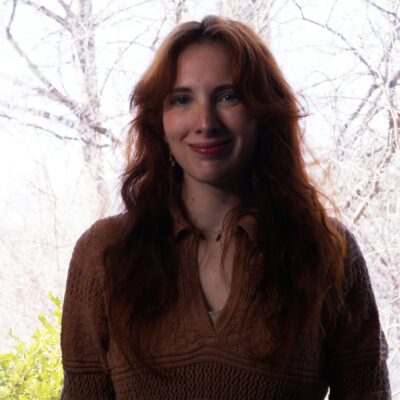Student Spotlight: Kirsten Keleher

April 21, 2025
Kirsten Keleher is a doctoral candidate in neurobiology and behavior from Cary, North Carolina. She earned her B.S. in fisheries, wildlife, and conservation biology at North Carolina State University and now studies the floral traits that are attractive to certain groups of pollinators under the guidance of Rob Raguso and Irby Lovette at Cornell.
What is your area of research and why is it important?
My research is focused on understanding the floral traits that are attractive to certain groups of pollinators. Often, these traits are consolidated into a floral “syndrome,” which is a set of visuals, scents, and tastes that are considered consistently desirable for a certain organism’s sensory system. The majority of my thesis research is focused on understanding the bird pollination syndrome, where flowers are red, tubular, unscented, and with high volumes of dilute nectar. However, many of these traits have not actually been tested in terms of their attractiveness to bird pollinators, and the syndrome generally focuses on hummingbird pollinators when there are many other families of birds that pollinate plants.
What are the larger implications of this research?
My research will allow us to better understand the diversity of relationships between birds and flowers, and how they have evolved together. In understanding what attracts birds to flowers and why birds may make better pollinators in certain circumstances, we will be able to better appreciate the environment and protect it from anthropogenic impacts. This research will also benefit local communities as it may facilitate the planting of native flowers in certain regions to attract a wider variety of backyard visitors.
What inspired you to choose this field of study?
I was initially drawn to this field by a love for insects, and after an undergraduate class on local flora, I was inspired to study the two in tandem. During rotations in the first year of my Ph.D., I had the opportunity to go to Australia to study variation in the song and dance displays of the superb lyrebird, and while there I became fascinated with the diverse bird pollination systems. Collectively, this led me to become particularly interested in pollinator shifts between birds and insects in closely related flowers.
You are an author on “Spatial partitioning of floral volatiles provides a ‘chemosensory roadmap’ for bumblebee pollinators,” recently published in Current Biology. What is the significance of the research/findings?
We found that in complex, tubular flowers, in two species of the genus Impatiens, there appears to be partitioning in the location and concentrations of various volatile organic compounds (VOCs). Generally, when we think about floral VOCs, we consider how they are processed olfactorily; in this study we also examined the gustatory responses of bumblebee pollinators to compounds from various parts of the flower when combined with a sugar water reward. We found that VOCs associated with the nectar were agreeable to the bumblebees when tasted, but those that were associated with other floral tissues were not. We believe this is meant to encourage potential pollinators to enter the flower properly, as opposed to robbing the flower and not providing pollination services.
What are your hobbies or interests outside of your research or scholarship?
I love nature photography as it gives me the chance to see the world from a different perspective. I am interested in the intersection of art and science, particularly how art can be used for scientific communication. I also enjoy baking, knitting, gardening, and hiking. Finally, I volunteer at the Cornell University Insect Collections, where I am in the process of rehydrating and spreading a collection of African moths.
Why did you choose Cornell to pursue your degree?
I chose Cornell because I appreciated how interconnected the different departments are. Coming from a natural resources program, the shift into a neurobiology and behavior program seemed like quite a leap in terms of ideologies, but when interviewing and visiting, I saw how close collaborations are fostered with departments like ecology and evolutionary biology and entomology. This has been especially beneficial in my case, as I am co-advised by faculty members in neurobiology and behavior and ecology and evolutionary biology, which has given me the opportunity to pursue my interests that combine the two fields.
